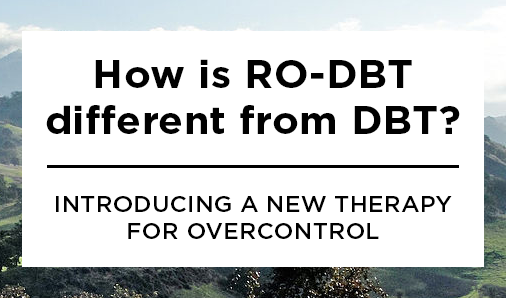Developed by Marsha Linehan, PhD, Dialectical Behavior Therapy (DBT) is a cognitive behavioral treatment that was originally developed to treat chronically suicidal individuals diagnosed with borderline personality disorder (BPD). Radically Open-Dialectical Behavior Therapy (RO-DBT) builds upon DBT. This new therapy is a breakthrough, transdiagnostic approach (developed by Dr. Thomas Lynch) that helps clients with extremely difficult-to-treat overcontrol (OC) disorders such as anorexia nervosa, chronic depression, and obsessive-compulsive disorder (OCD).
If you are already familiar with DBT, check out the main differences between Radically Open DBT and traditional DBT below.
DBT |
RO-DBT |
|---|---|
| Uses behavioral principles | Uses behavioral principles |
| Uses dialectical philosophy | Uses dialectical philosophy |
| Developed for undercontrolled clients
Cluster B “dramatic erratic” personality styles, mainly borderline and antisocial PD |
Developed for overcontrolled clients
Clusters A and C “overcontrolled” personality styles (e.g., avoidant, obsessive compulsive, paranoid and schizoid PDs, but also chronic depression and anorexia nervosa) |
| Client has anxious attachment style
Seeks attachment with therapist and fears abandonment |
Client has avoidant attachment style
Does not seek attachment with therapist and abandons relationship easily, especially when there is conflict |
| Core problem
Emotion dysregulation, poor impulse control |
Core problem
Social signaling deficits, low openness, and aloofness |
| Suicide and self-harm
Undercontrolled (UC) clients engage in self-harm and suicide at high rates
|
Suicide and self-harm
Overcontrolled (OC) clients engage in self-harm and suicide at high rates
|
| Therapist recognizes that undercontrolled clients need to do better, try harder, and/or be more motivated to change | Therapist recognizes that clients characterized by overcontrol need to let go of always striving to perform better or try harder |
| Therapeutic stance
Therapist uses external contingencies, including mild aversives, takes a direct stance in order to stop dangerous, impulsive behavior |
Therapeutic stance
Therapist is less directive, encourages independence of action and opinion, emphasizes self-enquiry and self-discovery |
| Teaches the therapist
How to use external contingencies to help the client gain control and discover the reinforcing consequences of impulse control |
Teaches the therapist
How to use social signaling to enhance client engagement and model vulnerability and connectedness |
| Primary therapeutic focus
Internal: emotion regulation skills, gaining behavioral control, and distress tolerance |
Primary therapeutic focus
External: social-signaling, openness, and social connectedness skills |
| Teaches
How to avoid conflict, be more organized, restrain impulses, delay gratification and tolerate distress (skills already over learned or engaged in compulsively by most OC individuals) |
Teaches
Clients to increase openness, flexible responding, enhance social connectedness, and vulnerable expression of emotion |
| External contingencies, including mild aversives, help the client gain control and discover the reinforcing consequences of impulse control | Emphasis is on self-enquiry and self-discovery rather than impulse control |
| Therapist may encourage brief disengagement from conflict
to reduce/avoid escalation |
Therapist encourages engagement if a conflict exists
rather than automatic abandonment or avoidance |
| Therapist rewards
regulated and measured expression of emotions and thoughts |
Therapist rewards
candid disclosure and uninhibited expression of emotion |
Treatment target hierarchy
|
Treatment target hierarchy
|
| Prioritizes therapy interfering behaviors
Positioned second in the treatment hierarchy, therapy interfering behaviors are seen as problems necessitating change |
Prioritizes therapeutic alliance ruptures
Positioned second in the treatment hierarchy, alliance ruptures are seen as opportunities for growth – thus are welcomed |
| Mindfulness practices informed by Zen Buddhism | Mindfulness practices informed by Malamati Sufism |
Mindfulness
|
Mindfulness
|
| Emphasizes and prioritizes Radical Acceptance
Radical Acceptance is “letting go of fighting reality” “It is the way to turn suffering that cannot be tolerated into pain that can be tolerated” (Linehan 1993). |
Emphasizes and prioritizes Radical Openness
Radical Openness is actively seeking the things one wants to avoid in order to learn—challenging our perceptions of reality, modelling humility, and a willingness to learn “We don’t see things as they are—we see things as we are” (Lynch 2017). |
| Emphasizes internal emotion regulation and non-mood dependent actions | Emphasizes our tribal nature and social-connectedness |
| Does not take temperament into account | Prioritizes interventions designed to take temperament into account
Temperament (genetics for emotion) influences the perceptual and regulatory biases clients bring into social situations and needs to be accounted for when treating clients |
| Does not target bio-temperament | Targets bio-temperament
With specific skills via activation of neural substrates |
 Thomas R. Lynch, PhD, is the treatment developer of Radically Open-Dialectical Behavior Therapy (RO-DBT)—a new transdiagnostic treatment approach for disorders of emotional overcontrol, informed by 20+ years of clinical research. Dr Lynch is currently Professor Emeritus in the School of Psychology at the University of Southampton, and before that he was the Director of the Duke Cognitive Behavioral Research and Treatment Program at Duke University (USA) from 1998-2007.
Thomas R. Lynch, PhD, is the treatment developer of Radically Open-Dialectical Behavior Therapy (RO-DBT)—a new transdiagnostic treatment approach for disorders of emotional overcontrol, informed by 20+ years of clinical research. Dr Lynch is currently Professor Emeritus in the School of Psychology at the University of Southampton, and before that he was the Director of the Duke Cognitive Behavioral Research and Treatment Program at Duke University (USA) from 1998-2007.
His companion books on Radically Open Dialectical Behavior Therapy are now available.


 2024 Peace Playbook: 3 Tactics to Avoid Clashes with Your Partner
2024 Peace Playbook: 3 Tactics to Avoid Clashes with Your Partner